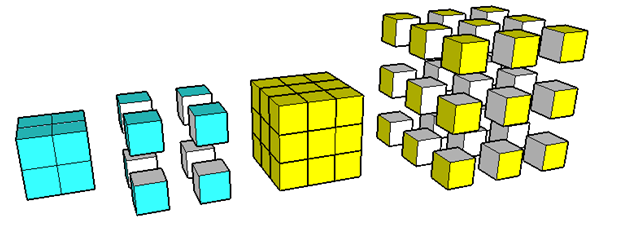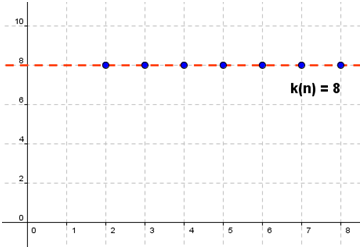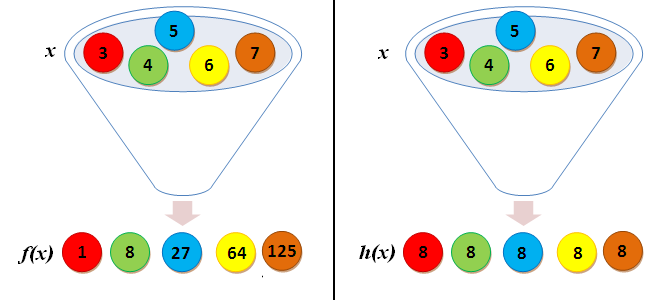Basic Concepts of Functions
Note: This is the second part of the Functions Series. To view the other parts, click the link below.
Part I: Introduction to Functions
Part II: Basic Concepts of Functions
***
In the first part of this series, we have discussed that a function is a relationship between two sets where for each value in the first set, there is exactly one corresponding value in the second set. We have painted large cubes, cut them into unit cubes and found a pattern about the number of cubes with 3, 2, 1 and no painted faces.

Figure 1 – Cubes painted and sliced into unit cubes.
We found out that if a cube has side n units, if we painted all of its faces and cut it into unit cubes, the following relationships hold:
If
f(n) = number of core cubes (cubes with 0 painted face) of an cube with side length n
g(n) = number of wall cubes (cubes with 1 painted face)of a cube with side length n
h(n) = number of edge cubes (cubes with 2 painted faces) of a cube with side length n
k(n) = the number vertex (cubes with 3 painted faces)cubes with side length n
then
f(n) = (n – 2)3 = n3 – 9n2 + 27n – 27
g(n) = 6(n-2)2 = 6n2 – 24n + 24
h(n) = 12(n-1) = 12n- 12
k(n) = 8
To give you a clearer understanding about functions, let us consider some more examples:
1.) The relations y = 2x is a function, since clearly, for each value of x, there is exactly one corresponding value of y.
2.) If a person is working in which the salary is computed per hour, we can say that his salary is a function of the time (number of hours) denoted by f(t) he has worked. If we let s be the salary and t be the time, we can write s = f(t). The relationship is a function, since for any number of hours work rendered, there is an exact corresponding salary.
3.) The relation f(x) = (x – 2)3 is a function because for each x, there is exactly one f(x). Some of the values of x and f(x) are shown in the left most diagram in Figure 1.

Figure 2- Mapping representation of functions and relations.
4.) The relation h(x) = 8, is a function since for each x, there is only one value for f(x), which is 8. The mapping is shown in the center diagram shown in Figure 1.
5.) The relation x = y2 as shown in Figure 2 is not a function because we can find an x with different values of f(x). For instance, when x = 4, then y2 = 2 and y2 = -2. The mapping of the elements of s = y2 is shown in the rightmost diagram in Figure 1.

Figure 3 – The graph of x = y squared.
6.) The only possible values of n in our cube problem are integers greater than 1. We cannot have a cube with fractional length, such as 5.6 meters because our condition says to cut the cube into unit cubes (cubes with side length 1 unit). Moreover, n cannot have negative values since a negative number of unit cubes does not make sense. The possible values of n, that makes the value of f(n) sensible is called the domain of the function.
7.) In the relationship h(n) = 12n – 12, the number of edge cubes h(n) depends on the side length n of the cube. For instance, if n is 100, we can easily compute the value of h(n). We call n our independent variable and h(n) our dependent variable. Note that not all h(n) has corresponding value of n. For instance, the value h(n) = 21 has no corresponding value of n.
8.) Whatever the value of n, k(n)=8. We call k a constant function. In Figure 3, if we let our domain be the set of real numbers, then, we will have a horizontal line.

Figure 4 – The graph k(n) = 8.
9.) Functions are sometimes named by the letter of their names and not including the independent variable. For instance, instead of f(x), we can call it simply f.
10.) The degree of a function is the highest degree of the simplified polynomial. Looking at the simplified formula above, We can see that f has degree 3, g has degree 4 and h has degree 1. Functions with degree three are called cubic functions, those with degree 2 are called quadratic functions, and functions whose degree is 1 are called linear functions.
11.) Some functions have their domain specified. If no specification is a available, then it is assumed the domain is the set of real numbers. The domain of the function h(n) = 12n – 12 is the set of integers greater than 1. The possible values of of f(n) is called the range of h(n). Hence the domain of h(n) are 2, 3, 4, and so on and its range of h(n) are 12,24,36 and so on or the set of positive integers that are multiples of 12.
12.) A function is like a machine where each input releases one (and only one) output. In Figure 5 (left), x values are our input balls and f(x) values are our output balls. As you can see, each input ball returns a single output ball; that is, a ball of the same color. This is also the same in the with the figure at the right (where h(x) are our output balls) even though the values of all the output balls are the same.

Figure 5 – The Function Machine
On the contrary, in Figure 6, each input ball has two output balls. This means that the relationship is not a function.

Figure 6 – A relation that is not a function.
In the next post, we will discuss about the horizontal and the vertical line test and their connection with the definition and properties of functions.